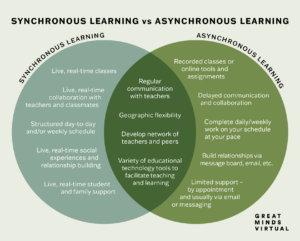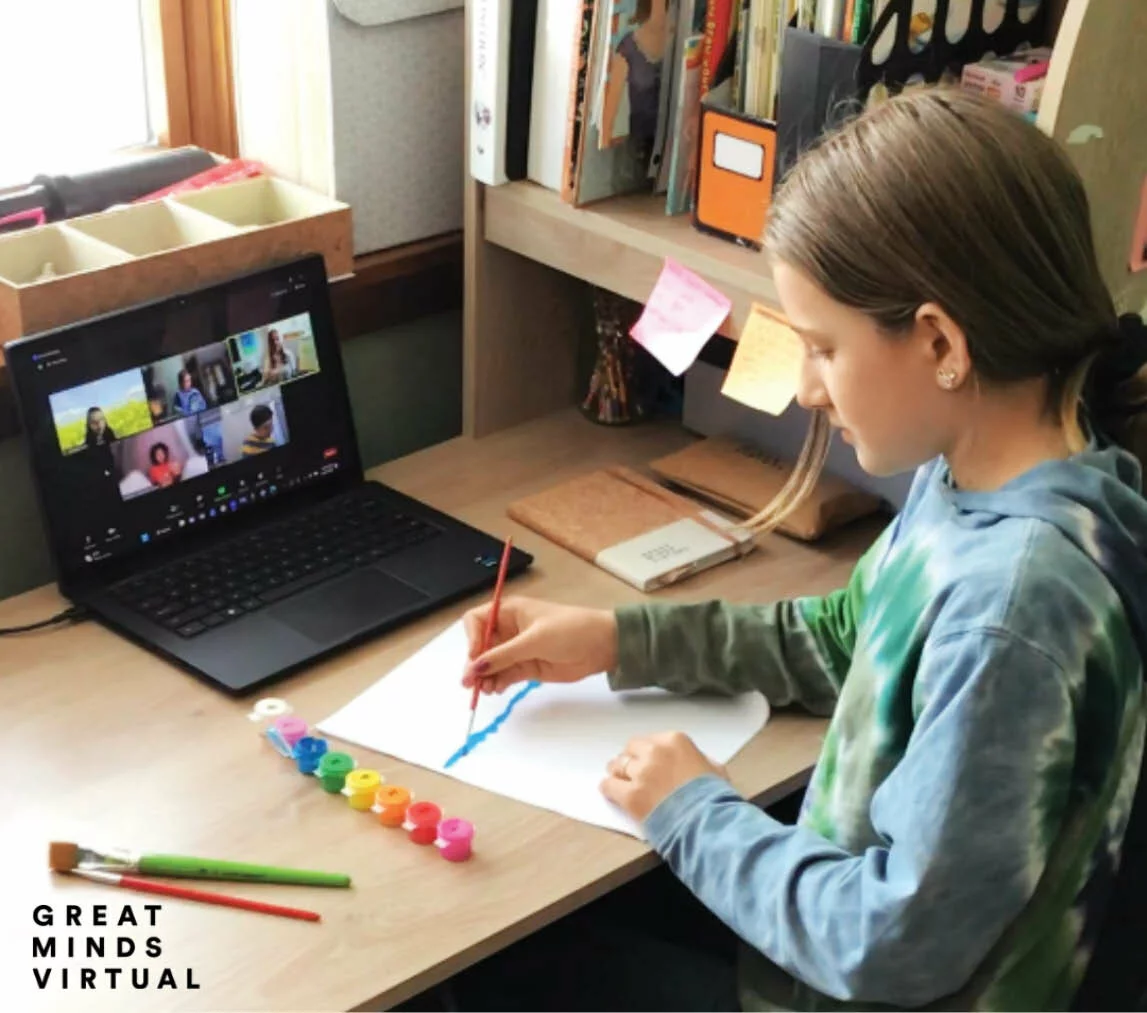If you’ve found your way to this blog post, you’re probably already considering a virtual school for your child. Perhaps you’ve even read our post about choosing between a traditional brick-and-mortar school and a virtual school and you want to learn more about the options available for online learning.
However you got here, we’re glad you did. Why? Because even though virtual learning sounds pretty simple, there are actually a lot of factors to think about, and making the right choice can make all the difference when it comes to your child’s happiness and success in school. One of the most important considerations in choosing an online school is whether they offer synchronous or asynchronous learning.

Understanding the differences between synchronous and asynchronous learning
While brick-and-mortar schools provide synchronous learning, most virtual schools and programs use an asynchronous learning model. But what do synchronous and asynchronous mean, and why is it important to know which approach the schools you’re considering take?
Chronos is the ancient Greek word for time. Syn- is a prefix that means “together” and asyn- means “not together.” So, synchronous simply means “together and at the same time” and asynchronous means “not together and not at the same time.”
Synchronous learning, then, is live learning together and at the same time, with classmates and teachers. Although it is the most obvious approach in a traditional brick-and-mortar school, it also works in a virtual learning environment.
With asynchronous learning, most commonly associated with a virtual environment, students learn separately and on their own schedule. This approach, or a hybrid version (discussed below), like that offered by Great Minds Virtual, might be what you’re looking for if your family travels or moves often, if your child pursues time-intensive interests outside of school, or if learning on a flexible schedule would benefit your child for any other reason.
3 questions to ask when considering an asynchronous approach
1. How much time will my child spend with their teachers?
In an asynchronous environment, where there is little (if any) face-to-face interaction, one teacher might be responsible for over 100 students. This means that your child might only see a teacher for a few minutes a day or even just a few minutes a week, and might not receive individualized attention and support when it’s needed.
2. How much support is available for my student?
With asynchronous learning, parents often have to supplement the instruction by teaching the material themselves or hiring a tutor. Some virtual schools provide extra support for an additional charge. Before enrolling your child, make sure you understand just how much time they will spend with their teachers and how much extra support you may need to provide. And if tutoring, small-group, or one-on-one support is available, make sure to ask if there are any associated costs.
3. Will my student spend time online with other students?
With asynchronous learning, students don’t usually have the option to share their ideas and collaborate with their classmates in person. If students do communicate with each other, it may be only through static discussion boards that lack the dynamic spark of a live discussion. Yet we know that students build knowledge most effectively through meaningful collaboration and discussion. Find out if the school you’re considering provides opportunities for live group learning and collaboration, and how effectively those opportunities engage students.
Academics aren’t the only concern—community-building doesn’t just impact your child’s learning, it also impacts their social-emotional development and their happiness and well-being. Ask how the school helps your child develop and maintain friendships and build community.
3 questions to ask when considering a synchronous approach
1. What flexibility will my child have to pursue their outside interests and passions?
Schools that use a synchronous learning model typically offer a structured schedule that mimics a traditional brick-and-mortar schedule. While this might work well for some, for others it may lack the flexibility needed to pursue interests (such as sports, music, or leadership) that take a lot of time.
2. How many students are in my child’s class?
Smaller class sizes can mean more collaboration between students, more focused attention from teachers, and higher levels of student engagement. In a virtual setting especially, smaller classes can make a world of difference, but only if the opportunity exists for students to engage and collaborate. If the teaching and learning model employs a largely ineffective lecture format, for example, class size won’t make a difference. If your child learns best with face-to-face discussion, look for small classes that offer meaningful interaction, both with other students and between students and teachers.
3. What types of social and community-building interactions will my child have with other students?
Even if your school approaches teaching and learning through whole-group, small-group, and one-on-one experiences, make sure you also ask about opportunities for students to socialize, make friends, and build community with their classmates. At Great Minds Virtual, for example, students start and end their days in small-group advisory sessions, with 6–10 students and one faculty member. They also have the opportunity to eat lunch together and make friends through co-curricular activities and clubs.
If you’re looking for maximum flexibility, look for a school or program that provides an asynchronous approach. If you’re looking for a more structured experience where your child attends classes with other students in real time, look for a school that offers a synchronous approach.
If you’re looking for a happy medium—structured, synchronous learning along with flexible, asynchronous experiences—look for a school that offers a hybrid approach. For example, at Great Minds Virtual, students learn synchronously for the first part of their day. In the afternoon, they have time on their own to complete asynchronous work or receive one-on-one support from their teachers. This flexibility allows student-athletes, performers, or students with other time-intensive interests to attend practices, rehearsals, and other activities.
You have lots of choices when it comes to your child’s virtual education. We hope this short guide has helped you understand how synchronous, asynchronous, and hybrid approaches differ and identify which might be the best fit for your child and your family.





